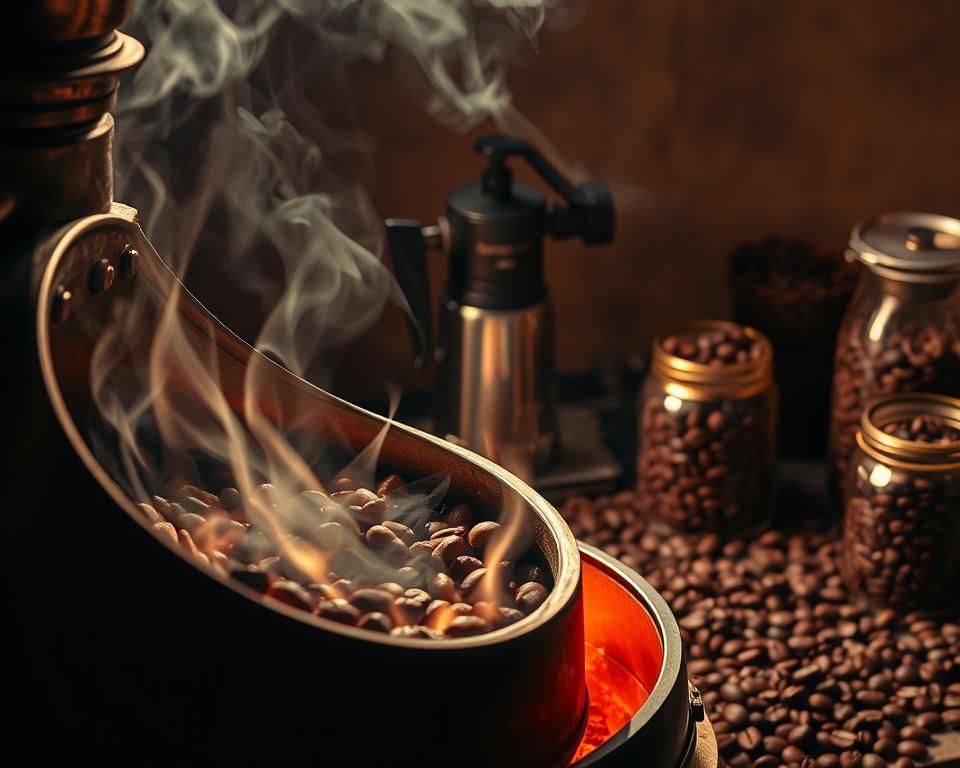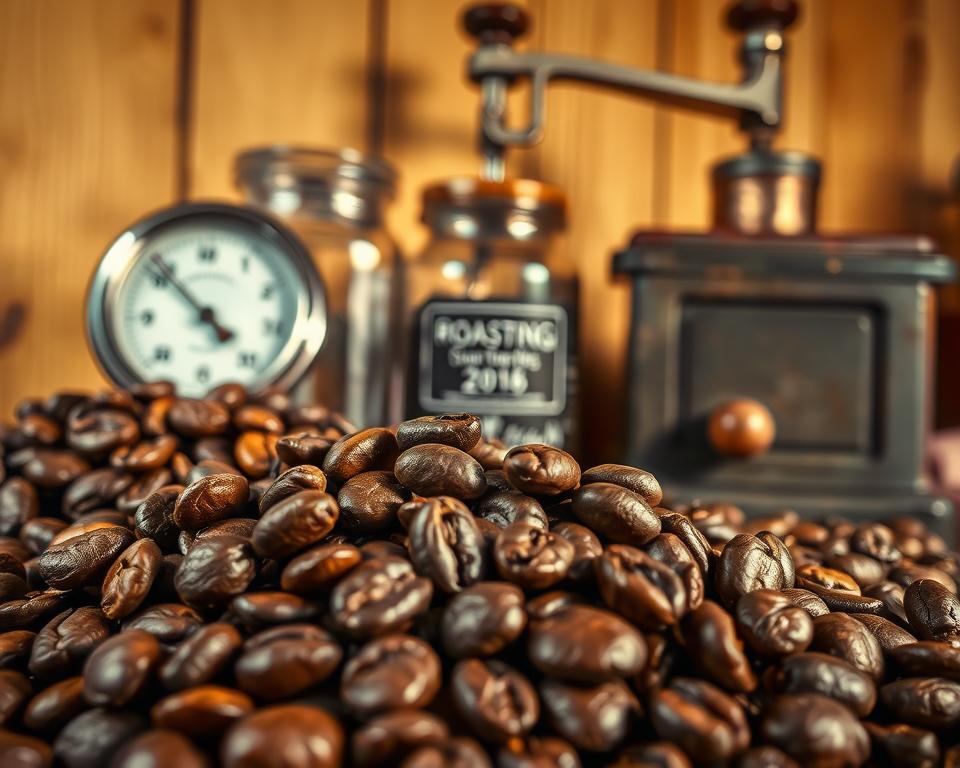Coffee freshness is heavily influenced by the roasting date, marking when the beans were roasted. Grasping the concept of roast dates is key to selecting the freshest, most flavorful coffee. The roasting date shapes the coffee’s taste, impacting the brewing experience. Baristas generally advise consuming beans within 7-21 days post-roast for the best taste.
Beans can start losing flavor as soon as 3 weeks post-purchase. Proper storage can extend their usability to 1 year after opening. Yet, beans can spoil before their listed expiry if not stored correctly. Air exposure is a major culprit in this degradation. For coffee aficionados, knowing the ideal roasting date is vital to enjoy the coffee’s full flavor potential.
Key Takeaways
- Understanding the roasting date is essential for optimal coffee freshness
- Coffee beans should be consumed within 7-21 days after the stated roast date for optimal flavor
- Proper storage can keep coffee beans fresh for up to 1 year after opening
- Coffee beans can lose flavor intensity as early as 3 weeks after the purchase date
- The roasting date affects the flavor profile of the coffee and the overall brewing experience
- Coffee freshness diminishes significantly once oxygen begins to enter the beans
Understanding the Roasting Date Concept
Coffee freshness is greatly influenced by the roast date, marking when the beans were roasted. This date differs from the expiry date and is key to knowing when to enjoy the coffee. Reputable roasters label the roast date on their packaging, helping consumers choose wisely. The art of bean roasting and roast profiling is essential for the coffee’s flavor and quality.
Understanding the roasting date’s impact on flavor is crucial. Coffee is at its best between 6-14 days after roasting, with flavor peaking during this time. Beyond this, the taste can drop, needing more coffee to taste as good. The first week is critical, as the coffee releases CO2 rapidly, affecting brewing consistency. Learning about coffee freshness highlights the roast date’s significance.
- Coffee flavor can diminish significantly past the 14-day mark, often requiring a higher dose to achieve similar taste results.
- Extraction inconsistencies can lead to unpredictable results for baristas from day two to day four after roasting.
- Single Origin coffees maintain optimal flavor clarity and profile best within the 6-14 day range and lose value with each passing day in the hopper.
By grasping the roasting date concept and its flavor impact, consumers can make better coffee choices. They’ll appreciate the role of bean roasting and roast profiling in crafting their coffee.
The Science Behind Coffee Freshness
Coffee freshness is a complex phenomenon influenced by various factors, including the coffee roasting process and roast date significance. Understanding these factors is crucial to appreciating the science behind coffee freshness.
The coffee roasting process transforms green coffee beans into the flavorful, aromatic beans we use to brew coffee. This process affects the roast date significance, as it determines the optimal time for consumption. Factors such as temperature, moisture, and oxygen exposure play a significant role in the degradation of coffee freshness.
Some key factors affecting coffee freshness include:
- Temperature: A 10°C increase in temperature can lead to a 50% reduction in the shelf life of roasted coffee.
- Moisture: Higher humidity levels accelerate flavor degradation in coffee, shortening its shelf life.
- Oxygen exposure: Exposure to oxygen causes loss of volatile organic compounds (VOCs) and may result in off-flavors due to oxidation.
The optimal freshness after roasting is typically found in a window of 4-14 days, with peak flavor usually occurring within this period. The rate at which coffee freshness diminishes varies significantly based on application, indicating a broad range depending on specific conditions.
| Coffee Type | Shelf Life |
|---|---|
| Green coffee beans | Approximately 1 year |
| Roasted whole coffee beans | Weeks to months |
| Ground coffee | A few minutes up to 2 months |
| Brewed coffee | Minutes |
By understanding the science behind coffee freshness and the factors that affect it, coffee lovers can appreciate the roast date significance and the coffee roasting process. This understanding enhances their coffee experience.
How to Identify Fresh Coffee
To identify fresh coffee, understanding the best roast date practices is crucial. Coffee beans are considered fresh for up to 2 weeks after roasting. The aroma of roasted coffee can show a noticeable loss of freshness within just one day. Fresh coffee is typically considered to peak in flavor within a window of 4-14 days after roasting.
When it comes to roasted coffee quality, the storage conditions play a significant role. Optimal coffee storage conditions include keeping beans in a suitable container in a dark cupboard. Valve-sealed coffee packaging can keep coffee fresh for up to 6 months before opening. For more information on coffee freshness, visit coffee freshness guide.
Some key factors to consider when evaluating the freshness of coffee include:
- Visual cues: Check for any visible signs of staleness or aging.
- Aroma indicators: Fresh coffee should have a vibrant, rich aroma.
- Taste testing methods: Brew a cup of coffee and evaluate its flavor profile.
By following these guidelines and understanding the best roast date practices, you can enjoy high-quality, roasted coffee that meets your standards. Remember, the optimal consumption period for coffee can vary depending on the blend and roast level, so it’s essential to experiment and find your preferred flavor profile.
| Coffee Type | Optimal Consumption Period |
|---|---|
| Espresso | 7-11 days after roasting |
| Drip/Pour-over | 4-7 days after roasting |
| Cold Brew | 10-14 days after roasting |
The Optimal Roasting Date for Different Brews
Coffee freshness is key to a perfect cup, and the roasting date’s impact on flavor is significant. The best roast date varies by brewing method and coffee type. Light roasts lose flavor quickly, while dark roasts keep theirs longer.
For coffee enthusiasts, grasping the roasting date’s effect on freshness is vital. Brew coffee within a week of roasting for the best taste. Yet, the ideal time varies by method. Espresso is best 5-11 days post-roasting, while drip or pour-over coffee benefits from 4-7 days’ rest.
Light vs. Dark Roasts
Light roasts are more sensitive to freshness, becoming stale fast. Dark roasts, though, hold their flavor longer. Finding the right balance between roast date and brewing method is essential for optimal flavor.
Brew Methods and Their Freshness Requirements
Different brew methods demand unique freshness levels. Cold brew coffee is best made 10-14 days after resting, while espresso is ideal 5-11 days post-roasting. Knowing these needs is crucial for enjoying your favorite brew at its peak.
To summarize, the optimal roasting date for different brews is as follows:
| Brew Method | Optimal Brewing Time |
|---|---|
| Espresso | 5-11 days after roasting |
| Drip or Pour-over | 4-7 days after roasting |
| Cold Brew | 10-14 days after roasting |
By understanding the roasting date’s impact and coffee freshness, coffee lovers can savor their favorite brew at its finest. Whether you prefer light or dark roasts, knowing the optimal brewing time is crucial for a perfect cup.
The Role of Packaging in Freshness
Packaging is vital for keeping coffee fresh. The packaging type greatly influences coffee’s shelf life. Factors like oxygen, light, and moisture impact its flavor and aroma. Proper packaging preserves the coffee’s taste, crucial for a great roast profiling and bean roasting experience.
Key packaging considerations include degassing valves, vapour barriers, and light protection. These elements reduce oxygen exposure, prevent moisture, and shield from light. For instance, vacuum-sealed bags significantly extend freshness. Nitrogen-flushed packaging replaces oxygen, slowing flavor deterioration.
The packaging material’s choice is also critical. Metal packaging offers top-notch protection but is pricey. Plastic packaging is more affordable and, with vapour barriers, protects against moisture and air. Biodegradable packaging balances preservation needs with environmental concerns.
| Packaging Type | Features | Benefits |
|---|---|---|
| Vacuum-sealed bags | Removes oxygen, prevents moisture absorption | Extends freshness, preserves flavor |
| Nitrogen-flushed packaging | Replaces oxygen, reduces oxidation | Mitigates flavor deterioration, preserves aroma |
| Biodegradable packaging | Eco-friendly, compostable | Reduces environmental impact, preserves coffee freshness |
The right packaging ensures coffee stays fresh and flavorful. This is key for a superior roast profiling and bean roasting experience. By understanding packaging’s features and benefits, roasters and consumers can choose the best options for their needs.
What Happens Over Time After Roasting?
The roast date is key to understanding coffee’s flavor. After roasting, coffee beans change in flavor, aroma, and quality. The roasting process turns green coffee beans into the brown ones we brew.
As coffee beans age, their taste and smell change a lot. The best flavor is usually found 4-14 days after roasting. During this time, they release carbon dioxide, impacting how they brew. Dark roasts stabilize quickly, while light roasts need more time, 5-10 days.
Several factors influence coffee’s freshness:
- Roast date: The date of roasting
- Storage conditions: Temperature, humidity, and oxygen levels
- Brewing method: Different methods need different freshness levels
Knowing about roast dates and the roasting process enhances coffee appreciation. It helps in making better choices when buying and brewing coffee. By considering these aspects, coffee lovers can enhance their brewing experience and enjoy the perfect cup.

| Days Post-Roast | Flavor Profile | Aroma |
|---|---|---|
| 4-14 days | Optimal flavor profile | Peak aroma |
| 15-28 days | Flavor degradation | Aroma loss |
| 29+ days | Significant flavor degradation | Minimal aroma |
Where to Find Roasting Date Information
To ensure you’re getting the best roast date practices and enjoying high-quality roasted coffee, it’s essential to know where to find the roasting date information. The roast date is usually mentioned on the packaging of the coffee, making it easy to determine the freshness of the beans. Reputable roasters provide the roast date on the packaging, allowing you to make informed decisions about your coffee purchases.
When buying coffee online, you can also find the roast date information on the product page or by contacting the seller directly. Some online retailers provide detailed information about the coffee, including the roast date, to help you choose the freshest beans. By purchasing coffee from reputable roasters and online retailers that provide accurate roast date information, you can enjoy the best roasted coffee quality and flavor.
Here are some ways to find roast date information:
- Check the packaging of the coffee for the roast date
- Look for the roast date on the product page when buying coffee online
- Contact the seller or roaster directly to ask about the roast date
By following these steps, you can ensure that you’re getting the freshest coffee possible and enjoying the best roast date practices. Remember, the freshness of coffee diminishes rapidly after about a week following roasting, so it’s crucial to choose coffee with a recent roast date to experience the optimal roasted coffee quality.
| Coffee Type | Freshness Duration |
|---|---|
| Coffee in paper-tin tie bags | 1-2 weeks |
| Valve-sealing packaging | up to 6 months |
| Bean & Bean Coffee’s Downtown Blend | up to 3 months |
How to Maintain Coffee Freshness at Home
Coffee freshness is key to its optimal flavor, and the roasting date’s impact is significant. To keep coffee fresh at home, proper storage is essential. Store coffee beans in a cool, dark, dry spot, away from sunlight and moisture.
Experts suggest storing coffee beans in an airtight container to preserve freshness. Buying coffee in smaller batches, enough for one or two weeks, helps ensure it’s consumed before flavor and aroma fade.
For brewing fresh coffee, use fresh, cold water and the correct coffee amount for your method. Here are some storage best practices:
- Store coffee beans in an airtight container
- Keep coffee beans away from direct sunlight and moisture
- Use coffee beans within a week or two of opening

By adhering to these tips and understanding the roasting date’s effect on coffee freshness, coffee enthusiasts can savor their favorite brew at its peak. Given coffee’s sensitivity to oxygen, light, heat, and humidity, preserving it is crucial.
| Coffee Type | Freshness Duration |
|---|---|
| Whole coffee beans | 4-6 weeks |
| Ground coffee | 1-3 weeks |
Purchasing Coffee: Timing your Buy
Timing your coffee purchases is crucial for enjoying the best-tasting brews. The roasting date is the key factor to consider when purchasing coffee beans. Ideally, you want to consume coffee within 7-21 days after the roasting date for optimal freshness and flavor. This window ensures the beans have had time to properly degas and develop their signature taste.
Seasonal Considerations for Freshness
Coffee lovers should also be mindful of seasonal factors when purchasing beans. Many specialty roasters source their beans from different regions throughout the year, so the roasting dates can vary considerably. Buying coffee during the off-season may result in less fresh beans, as they’ve been sitting longer before reaching the market.
Purchasing Strategies for Coffee Lovers
To ensure you always have access to the freshest coffee, consider purchasing from reputable roasters who clearly display the roasting date on their packaging. This transparency allows you to make informed decisions and time your purchases. Buying smaller quantities more frequently can help you enjoy the optimal freshness and flavor profile of your favorite beans.
FAQ
What is a roasting date?
Why is the roasting date important?
How do roasting dates affect the flavor of coffee?
What factors affect the freshness of coffee beans?
How can I identify fresh coffee?
What is the optimal roasting date for different brewing methods?
How does packaging affect the freshness of coffee?
What happens to coffee beans over time after roasting?
Where can I find information on roasting dates for coffee?
How can I maintain coffee freshness at home?

Tina Avila is a writer at WyNeeds, where she delves into the rich and diverse world of coffee. With a passion for flavors and brewing techniques, she brings insightful articles covering everything from coffee culture and bean origins to expert tips on making the perfect cup. Her goal is to inspire and educate coffee enthusiasts, helping them enhance their appreciation for every sip.

